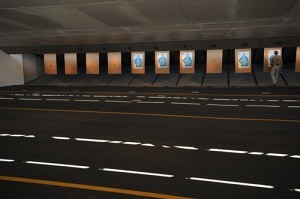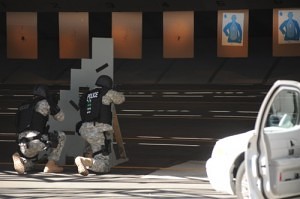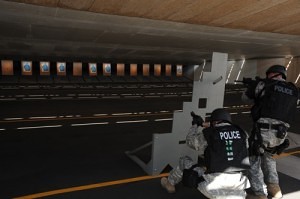Written by Clark Vargas
(Continued from last week…)There are inherent legal problems training with non-carry ammunition. The weight of non-lead bullets, are on average 25% less than that of standard lead projectiles by caliber and therefore accuracy is reduced at the firearms effective distances (long distances). Pistol harmonics and point of aim, likewise, change and occur at the shorter distance. So if a different practice round is trained with, the arguments can always be raised that it is different than the carry ammunition and the legal argument is created.
Military doctrine has always required engaging the enemy with mass firepower at the maximum effective distance of the firearm (whoever puts the most steel down range wins). Police trainers’ doctrine should also do the same. But, even if you are practicing and not hitting to the same point of aim with the duty and practice ammo, the lighter, non-lead practice ammo won’t do.
 Training with firearms requires developing proficiency at the weapons tactical or practical longest distances. That must be learned first. Close in rapid tactical drills come in second. However, if perceived recoil is different between a 100-grain and 140-grain bullet, a legal argument is again created.
Training with firearms requires developing proficiency at the weapons tactical or practical longest distances. That must be learned first. Close in rapid tactical drills come in second. However, if perceived recoil is different between a 100-grain and 140-grain bullet, a legal argument is again created.
Non-lead practice ammunition has no military value for combat. Lead again is and remains because of its weight and position in the periodic table, the main component for small arms projectiles of choice.
In our [Clark Vargas & Associates] opinion, LEO’s need to practice and qualify with what the less expensive issue ammunition or be subject to lawsuit, especially after a “bad” shooting incident. From a cost stand point, why shoot more expensive copper frangible and then have to qualify with lead on the same range when what you end up doing is contaminating the existing copper dust deposits with lead and then you can’t recycle any of it?
 The big break in ammunition technology, with respect to LEO training and environmental concerns, has only been the development of the lead heavy metal free reliable primers. Air sampling conducted at live shoots, with various totally encapsulated projectiles and lead free primer products is reported to have consistently proven to totally eliminate breathable lead exposure at the firing line.
The big break in ammunition technology, with respect to LEO training and environmental concerns, has only been the development of the lead heavy metal free reliable primers. Air sampling conducted at live shoots, with various totally encapsulated projectiles and lead free primer products is reported to have consistently proven to totally eliminate breathable lead exposure at the firing line.
The problem with the acceptance of the non-lead primed ammunition for tactical use has been that the non-lead primers are less sensitive than those with lead styphnate primer and increases the chance of misfires occurring, due to no ignition. This problem is being worked on. We certainly do not want misfires happening in a shoot out. Another problem is that non-lead primers were and are hydroscopic and may not store well.
Blount, Remington and Winchester as well as others, continue development with new ways of manufacturing propellant charges with non-metallic and non-lead bullets. Blount, CCI Blazer’s appear to be setting the standards in this area of technology with their more reliable lead-free primers. Lead free primers have little effect on velocity and points of aim, thus maintaining weight and velocity consistent to that of standard lead primed current carry ammunition.
 If a department is unwilling or unable to implement the lead management practices that we have known of for 12 years now, then perhaps they should use non-lead “green ammunition”. It should be realized though that the use of green ammunition is only one of the many alternative Best Management Practices for shooting ranges. It is not, however, the panacea and their use will have unintended consequences. The problems with non-lead alternative projectiles go far beyond the cost of the round. There are the ballistic performance shortcomings as previously discussed and yet unknown health and environmental risks. We know the risks for lead and know how to handle them.
If a department is unwilling or unable to implement the lead management practices that we have known of for 12 years now, then perhaps they should use non-lead “green ammunition”. It should be realized though that the use of green ammunition is only one of the many alternative Best Management Practices for shooting ranges. It is not, however, the panacea and their use will have unintended consequences. The problems with non-lead alternative projectiles go far beyond the cost of the round. There are the ballistic performance shortcomings as previously discussed and yet unknown health and environmental risks. We know the risks for lead and know how to handle them.
A fine point, but points to be considered by the industry are non-lead ammunition. It is available to the military and law enforcement but is illegal for the public to purchase or possess. Frangible copper ammunition is not designed for hunting and if used, a brush buster shot or a bad hit would result in only wounding and animal cruelty. Non-lead ammunition is not accurate enough for competitive target shooting.
We now believe that zinc ammunition will be removed from the market place shortly so we won’t discuss that further. However, the Army’s tungsten “green bullet” a more recent debacle is a perfect example of the unknown risks of proposed “wondermetals”. On paper the tungsten metal compound proposed for the Army’s “green bullet” program looked great and development went forward. When real-world fate and transport studies were done, it turned out that the tungsten compound created unintended consequences worse than lead. Soil pH dropped as much as 5 full points, resulting in negative impacts on vegetation and organisms in the environment, as well as having 100% cancer rates in test rats. Can you imagine what could have happened if implemented for existing military ranges? The use of the Army’s “green bullets” on an existing lead range would have decreased soil pH and INCREASED lead mobility in large sites. Clearly not the intended result!
 The Federal Law Enforcement Training Center, FLETC, has committed to 16 million rounds per year and is “the driving force behind the development of lead alternative ammunition”, but FLETC also has also acknowledged that lead alternative ammunition technology is NOT acceptable for duty use; they express a desire and opinion that it will be someday. FLETC developed their lead abatement strategy because of citations by EPA prior to the EPA’s development of lead Best Management Practices (BMP’s) and an EPA action due to FLETC’s past problems managing lead.
The Federal Law Enforcement Training Center, FLETC, has committed to 16 million rounds per year and is “the driving force behind the development of lead alternative ammunition”, but FLETC also has also acknowledged that lead alternative ammunition technology is NOT acceptable for duty use; they express a desire and opinion that it will be someday. FLETC developed their lead abatement strategy because of citations by EPA prior to the EPA’s development of lead Best Management Practices (BMP’s) and an EPA action due to FLETC’s past problems managing lead.
We have come through the zinc experiments and now in light of the Army’s green bullet test results, if, any assertion that non-lead ammunition is comparable to lead ammunition remarks is just plain wrong.
Balancing firearms training requirements vs. environmental stewardship is the balancing process the range design engineer and owner have to achieve. Completely eliminating an environmental risk is not possible. Minimizing risk certainly is.
I suggest totally encapsulated lead projectiles, non-lead primed ammunition for our designs. I take the common sense approach to the minimization of lead impacts on humans and the environment, and adopting range BMP’s as follows:
- Utilize totally enclosed jacketed ammunition
- Utilize lead-free primers
- Install proper ventilation to assure adequate air movement and pressure in the breathing space and HEPA filter the air to be breathed
- Instituting Range Operational Rules only proper ammunition used, wash hands, etc.
- Eliminating lead dust generation at the bullet trap by proper choice of traps.
- Recycle whatever you use
Utilizing the above BMP’s will eliminate 100% of the lead health safety problem in the range, due to projectiles.
Clark Vargas is a professional engineer and President of a successful 23-year-old civil/environmental engineering firm and has designed more than 30 shooting ranges in Florida, New York, Virginia, Tennessee and Kansas.

(NOTE: Action Target has republished this article in its entirety with the permission of the author. Ideas, comments, practices, recommendations, etc. are the author’s own and do not necessarily represent those of Action Target. Our line of indoor range products, which include our steel Total Containment and rubber traps, ventilation and dust collection meet and/or exceed all of Mr. Vargas’ recommendations/conclusions.)
If you have an article that you would like to see in our newsletter, please contact [email protected]
If you are interested in talking to a Territory Representative about your existing range or to discuss designing/building one, please click here.






